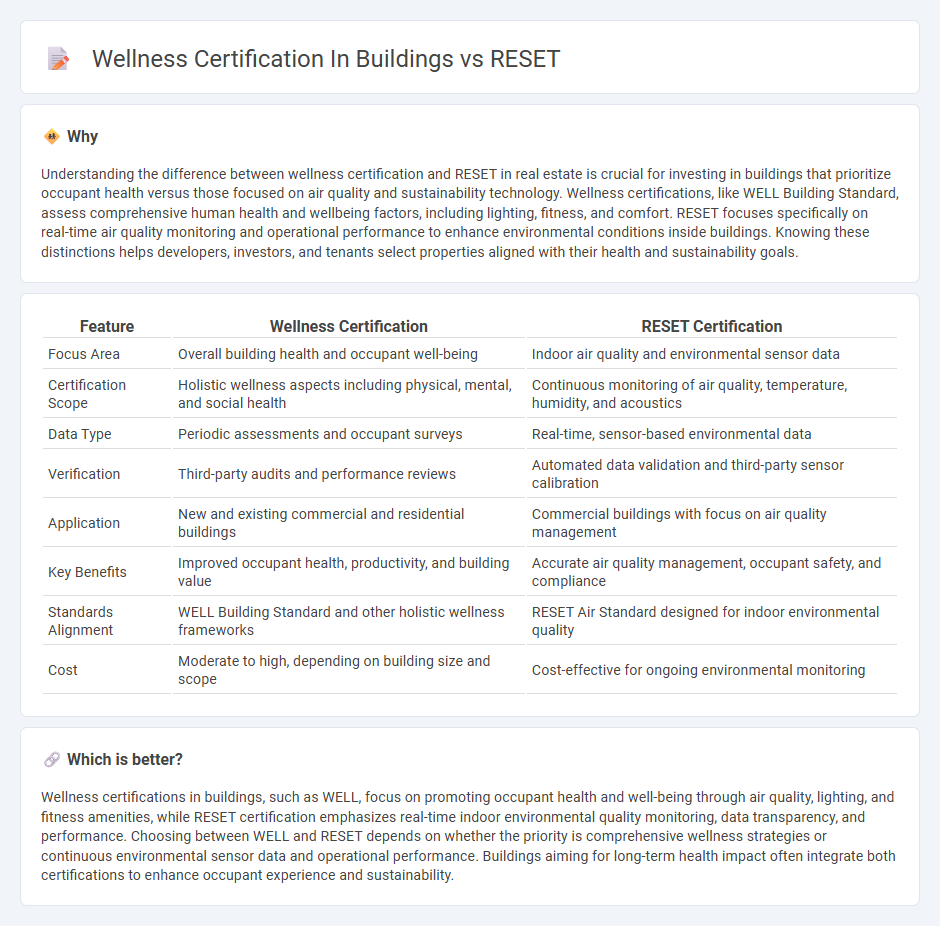
Wellness certifications in buildings, such as WELL Building Standard, focus on enhancing occupant health by optimizing air quality, lighting, and ergonomic design to promote physical and mental well-being. RESET certification emphasizes real-time monitoring of indoor environmental quality, using sensor data to ensure continuous performance in air quality, temperature, and humidity for healthier spaces. Discover how these certifications transform real estate by promoting sustainability and occupant health through innovative building standards.
Why it is important
Understanding the difference between wellness certification and RESET in real estate is crucial for investing in buildings that prioritize occupant health versus those focused on air quality and sustainability technology. Wellness certifications, like WELL Building Standard, assess comprehensive human health and wellbeing factors, including lighting, fitness, and comfort. RESET focuses specifically on real-time air quality monitoring and operational performance to enhance environmental conditions inside buildings. Knowing these distinctions helps developers, investors, and tenants select properties aligned with their health and sustainability goals.
Comparison Table
| Feature | Wellness Certification | RESET Certification |
|---|---|---|
| Focus Area | Overall building health and occupant well-being | Indoor air quality and environmental sensor data |
| Certification Scope | Holistic wellness aspects including physical, mental, and social health | Continuous monitoring of air quality, temperature, humidity, and acoustics |
| Data Type | Periodic assessments and occupant surveys | Real-time, sensor-based environmental data |
| Verification | Third-party audits and performance reviews | Automated data validation and third-party sensor calibration |
| Application | New and existing commercial and residential buildings | Commercial buildings with focus on air quality management |
| Key Benefits | Improved occupant health, productivity, and building value | Accurate air quality management, occupant safety, and compliance |
| Standards Alignment | WELL Building Standard and other holistic wellness frameworks | RESET Air Standard designed for indoor environmental quality |
| Cost | Moderate to high, depending on building size and scope | Cost-effective for ongoing environmental monitoring |
Which is better?
Wellness certifications in buildings, such as WELL, focus on promoting occupant health and well-being through air quality, lighting, and fitness amenities, while RESET certification emphasizes real-time indoor environmental quality monitoring, data transparency, and performance. Choosing between WELL and RESET depends on whether the priority is comprehensive wellness strategies or continuous environmental sensor data and operational performance. Buildings aiming for long-term health impact often integrate both certifications to enhance occupant experience and sustainability.
Connection
Wellness certification in real estate, such as WELL Building Standard, focuses on enhancing occupant health and well-being through indoor environmental quality, while RESET Certification emphasizes real-time data monitoring of air quality and building performance. Both frameworks aim to create healthier built environments by integrating advanced technologies and continuous performance tracking to ensure optimal indoor conditions. Together, they drive innovation in sustainable building design and operational efficiency, promoting occupant comfort and environmental responsibility.
Key Terms
Air Quality Monitoring
RESET certification emphasizes real-time air quality monitoring through continuous sensor data, ensuring indoor environments meet stringent standards for particulate matter, CO2, VOCs, and temperature. Wellness certifications often integrate qualitative assessments with periodic air quality checks, focusing on occupant comfort and broader health impacts. Explore how these certifications impact building performance and occupant well-being in detail.
Occupant Health
RESET certification prioritizes real-time air quality monitoring and sensor-based data to enhance occupant health by ensuring optimal indoor environmental conditions. Wellness certifications emphasize holistic approaches, integrating factors like natural lighting, thermal comfort, and biophilic design to promote physical and mental well-being. Explore detailed comparisons to understand how each certification impacts occupant health in buildings.
Certification Standards
RESET certification emphasizes real-time data monitoring and air quality to create healthier indoor environments, while WELL certification focuses on a comprehensive set of wellness factors, including air, water, nourishment, light, fitness, and comfort. Both certifications align with global health standards but differ in their approach: RESET prioritizes continuous performance verification through sensors, whereas WELL integrates design and operational strategies to enhance occupant health. Explore detailed comparisons to determine which certification standard best suits your building wellness goals.
Source and External Links
Reset - The term "reset" means starting something over again or adjusting it, often seen in contexts like resetting alarms or electronics to their original settings.
reSET - reSET is an organization that empowers entrepreneurs, focusing on social enterprise and community collaboration to address global challenges.
Reset - Reset is a financial tool that creates a dynamic spending limit based on income, bank balance, and upcoming bills to help manage budgets effectively.
 dowidth.com
dowidth.com